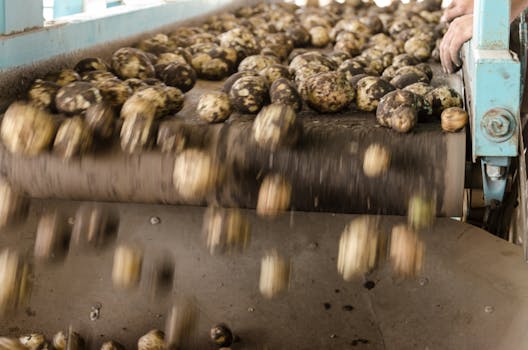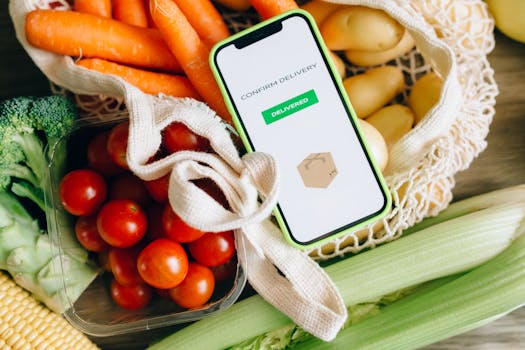Anuncios
As the digital age continues to evolve, tools that shape our daily lives also influence the food industry in remarkable ways. From the way we source ingredients to how we prepare meals, technology has become an essential part of our culinary experiences. This transformation not only enhances convenience but also allows for greater creativity in the kitchen.
Digital tools have redefined our relationship with food, making it easier to manage recipes, track nutrition, and even discover new cuisines. With the click of a button, recipes from around the world are accessible, enabling home cooks to experiment with diverse flavors and techniques. This level of connectivity fosters a more inclusive and adventurous approach to cooking.
Moreover, social media platforms and various applications have influenced how food is marketed, shared, and consumed. Visual platforms encourage home chefs to showcase their creations, while apps provide personalized nutrition advice and meal planning assistance. As a result, digital tools are not only improving our cooking skills but also approaching food from a new perspective.
The Role of Recipe Apps in Modern Cooking
Recipe apps are increasingly becoming popular among both novice cooks and culinary enthusiasts. These applications offer thousands of curated recipes, catering to a wide array of dietary preferences and restrictions. They often feature user-generated content, allowing cooks to share their personal adaptations and experiences.
Many recipe apps come equipped with special features such as step-by-step cooking instructions, embedded timers, and interactive grocery lists. These tools simplify the cooking process, making it easier for anyone to create delicious meals at home. The convenience provided by these features encourages people to cook more often.
Anuncios
Furthermore, recipe apps often allow users to filter by dietary needs like gluten-free, vegan, or keto. This inclusivity makes it easier for individuals to navigate their culinary options and maintain health goals without sacrificing flavor. Users can confidently explore new dishes knowing that their dietary requirements will be met.
As these applications develop, many also include meal planning functionality. This feature helps users save time by organizing their cooking schedule, preparing shopping lists, and even suggesting complementary dishes. By addressing multiple aspects of cooking, recipe apps streamline the culinary process.
The rise of recipe apps highlights the growing trend of digital cooking. With platforms like Yummly, Tasty, and Paprika gaining traction, it’s clear that technology is redefining how we engage with food and the cooking experience.
Anuncios
Online Grocery Shopping and Meal Delivery Services
The convenience of online grocery shopping has transformed the way consumers approach their food purchasing habits. Customers can now order groceries from the comfort of their homes, eliminating the need to venture out to stores. This shift has resulted in a significant increase in the popularity of e-commerce in the food sector.
Meal delivery services have emerged alongside online grocery shopping, providing pre-portioned ingredients and recipes to users. These services cater to various dietary preferences and skill levels, ensuring that anyone can enjoy cooking without the stress of meal planning. This method also helps mitigate food waste.
Moreover, many grocery apps allow customers to track their nutritional intake. This feature empowers users to make healthier choices, promoting mindfulness about what they eat. Detailed nutritional information is readily available, helping individuals stay accountable for their dietary decisions.
In addition, digital platforms often provide consumers with exclusive promotions and discounts. This incentivizes online shopping, making it a financially attractive option for many households. With the ability to compare prices and find deals quickly, customers can save both time and money.
The combination of online grocery shopping and meal delivery services indicates a growing reliance on digital solutions to meet food needs. This trend suggests a clear pivot towards convenience, accessibility, and healthier eating choices for consumers across the country.
The Impact of Social Media on Culinary Trends
Social media has proven to be a powerful influence in shaping culinary trends and food culture. Platforms such as Instagram and TikTok enable users to share mouthwatering food photos, recipes, and cooking videos. This visual platform encourages others to recreate popular dishes and engage with new cuisines.
Furthermore, the rise of influencers and food bloggers has democratized culinary expert advice. Many individuals follow food-centric accounts for inspiration, tips, and tutorials. This surge in connectivity nurtures a vibrant online food community, helping trends spread rapidly across platforms.
As these influencers showcase unique flavors and techniques, they inspire creativity among home cooks. The ability to watch others cook in real time creates a sense of connection and motivation, helping individuals feel more confident in their culinary skills. This encouragement drives people to experiment in their kitchens.
Additionally, hashtag challenges and viral trends on social media engage users in collective cooking experiences. From “Pasta Challenge” to “Sourdough Starter,” these trends not only promote experimentation but also foster a sense of belonging among participants. They share their creations using the same hashtag, creating a community around food.
The power of social media in culinary trends showcases how rapidly digital tools can influence cooking habits. The impact is undeniable, as it shapes tastes, preferences, and cooking styles throughout the country.
Nutrition Tracking and Health Apps
Nutrition tracking apps have gained significant popularity among health-conscious consumers looking to achieve their dietary goals. These applications enable users to log their food intake and keep track of their nutritional needs. By doing so, individuals can make more informed decisions regarding their health.
Additionally, many nutrition apps provide personalized recommendations based on individual dietary preferences and fitness goals. This data-driven approach helps users tailor their eating habits to support their overall well-being. With features such as barcode scanning and calorie counting, tracking becomes more manageable.
Moreover, these digital tools often allow for community engagement, fostering a support system among like-minded individuals. Users can share recipes, tips, and experiences, creating a network of motivation. This connection is especially beneficial for those looking to make long-term lifestyle changes.
Through gamification elements, many health apps encourage users to stay engaged. By setting milestones and rewarding achievements, these platforms foster a sense of accomplishment. This aspect enhances commitment to health goals and makes the process enjoyable.
In conclusion, nutrition tracking and health apps serve as impactful digital tools, aiding consumers in achieving their dietary aspirations. Their influence highlights the significant role technology plays in promoting healthier lifestyles.
Smart Kitchen Devices: Transforming Home Cooking
Smart kitchen devices are revolutionizing home cooking by integrating technology seamlessly into daily culinary tasks. Appliances such as smart ovens, programmable slow cookers, and connected thermometers offer unprecedented precision and convenience. These innovations take traditional cooking to the next level.
Many smart kitchen gadgets are designed to work in tandem with mobile applications, allowing users to control devices remotely. This capability provides cooks with the flexibility to manage their cooking schedules more effectively, leading to improved meal preparation. The smart features often include recipe recommendations and cooking tips.
Moreover, voice-activated devices simplify the cooking process, enabling users to multitask efficiently. Home cooks can request cooking times, measurements, or recipe steps hands-free, enhancing their kitchen experience. This interactivity fosters a fun and dynamic atmosphere while preparing meals.
Additionally, smart kitchen appliances contribute to energy efficiency by providing tools to manage cooking times and temperatures effectively. Users can ensure they use energy resources wisely, promoting sustainable cooking habits in the home. This focus on sustainability aligns with growing consumer awareness regarding environmental impact.
The integration of technology within kitchen appliances showcases the impressive evolution of cooking methods. As smart kitchen devices continue to emerge, they promise to enhance culinary experiences for consumers across the United States.
The Future of Food Technology
The future of food technology seems promising, with innovations set to redefine how we experience food. Advances in artificial intelligence, robotics, and biotechnology are likely to play significant roles in transforming the food landscape. These developments hold the potential to enhance food production processes and promote sustainability.
Additionally, vertical farming and hydroponic technologies are emerging trends that promise to provide fresh produce year-round. These techniques use digital monitoring systems to optimize growing conditions, ensuring quality and efficiency. As urbanization increases, these practices could address food security challenges while reducing transportation costs.
Furthermore, advancements in food safety technology will likely bolster consumer confidence. Innovations like blockchain can track food sources and verify quality, enhancing transparency within the food supply chain. This development will positively impact consumer choices, promoting greater trust in food products.
Moreover, the convergence of food and technology will likely continue expanding into areas like personalized nutrition and 3D-printed foods. This evolution opens doors for new possibilities, enabling customization of meals according to individual preferences and health goals. Such innovations could personalize dining experiences significantly.
In summary, the future of food technology is set to revolutionize the culinary landscape for consumers and providers alike. From sustainability practices to personalized nutrition, these advancements promise a new era in food experiences.
Conclusión
The undeniable impact of digital tools on food is reshaping culinary practices and consumer habits. From recipe apps enabling home chefs to explore diverse cuisines to smart kitchen devices enhancing cooking efficiency, technology has become integral to our food experiences.
As online grocery shopping and meal delivery services gain popularity, we can see how digital solutions provide inherent convenience. Moreover, social media continues to shape culinary trends, while nutrition tracking apps promote healthier lifestyles.
The evolution of food technology promises an exciting future, with innovations driving sustainability and personalization in meals. Ultimately, these developments indicate a shift towards a more connected and engaged approach to food.
Through all these advances, it is clear that digital tools will play a pivotal role in shaping the future of food and our relationship with what we eat.



